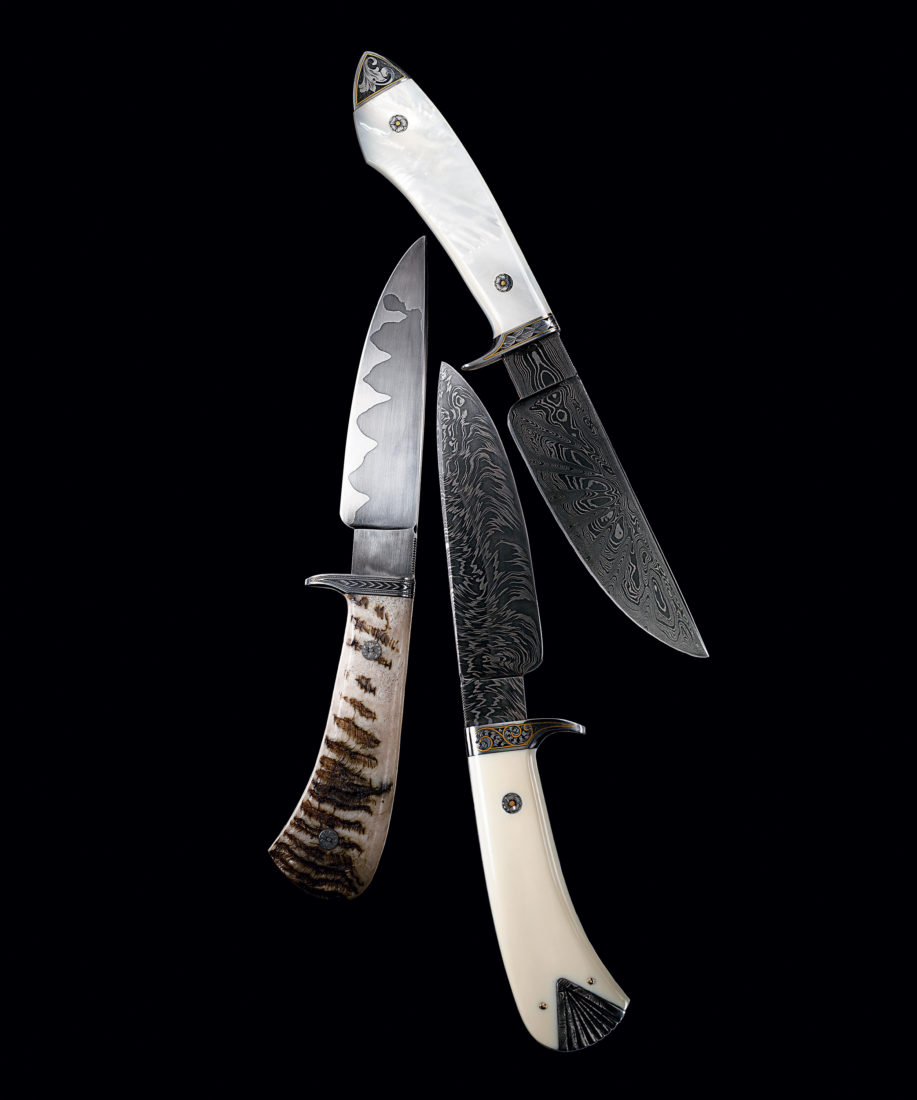In the backwoods of southwestern Arkansas, just off a ribbon of country road in the small town of Nashville, there’s a one-room metalworking shop packed with scraps of metal, grinders, and a forge that exhales blazing heat. Within, on pretty much any day of the week, you’ll find a man named Jerry Fisk sweating and (literally) burning as he hammers and grinds sheaths of steel into clean-lined knives, daggers, or swords. Fisk — a thick-drawled, bearded fifty-four-year-old who’s partial to jeans and cowboy boots — might just be the world’s finest bladesmith.
The native Arkansan — designated in 1999 a National Living Treasure — merges the disciplines of metallurgy, lapidary, and woodworking to handcraft knives treasured by collectors for their incomparable beauty and utility. His blades can literally split a hair. The scrolled engravings are so logical and natural that they seem to be an innate part of the source metal, drawn out in the forging process. His decorative handles are made from the finest wood or mammoth ivory, inlaid with mother-of-pearl, silver, or gold.
Fisk creates only thirty or so pieces a year. Prices range from $1,100 to $45,000. His clients include the sultan of Brunei and Wall Street billionaires. The queen of England’s official armorer has traveled to Arkansas to study with him. “But I sell my stuff to guys who mow lawns for a living, too,” he says.
When he was ten years old, Fisk went on a school field trip to Washington, Arkansas, to visit the forge where in 1831 James Black was commissioned by Colonel James Bowie to make the most famous piece of cutlery in American history. “There was this old man at the forge with these big and shiny blades. It so impressed me,” Fisk says. “I went home that night and carved my own bowie knife out of wood and stabbed one of my brothers. As my momma was whoopin’ me, I thought ‘I’m on to something here.’”
By his twenties, he was selling knives for apiece while working odd jobs to pay the bills. “I’ve been a bootlegger, a railroad man, and a chicken puller,” says Fisk. (Um, bootlegger? “I live in a dry county,” he says.) In 1987 he started making knives full-time.
Fisk chops two-by-fours in half, then actually splits one of his own hairs before he deems a blade ready
In the early days, most of his pieces went to bodyguards and mercenaries. “I sold them to Israeli groups and some others that I shouldn’t name,” he says. These days, his clients are mostly collectors who wait up to three years to get premium blades. The process usually starts with hand-selected metal. But Fisk is amenable to using anything a client wants. One man sent him twenty-five pounds of rusted barbed wire. Another sent him the hood of a wrecked Toyota. “Bladesmiths are the original recyclers,” he says.
Then Fisk fires up the forge, which reaches a high temperature of 2,400 degrees Fahrenheit. “I work with my face only thirty inches from the forge,” he says. “That’s why I wear a beard. When I smell burning hair, I know it’s time to back up.” He dips the blade into the forge, then hammers the metal over and over (some blades have up to twenty thousand layers). The sparks from the hammering have left constellations of scars on his arms. “I can take a pen and connect all the dots and make all kinds of pictures,” he says.
After smoothing out the blade with a hand grinder, Fisk puts it through a series of tests; he wants his clients to be able to use the knives for their intended purpose — say, as a field knife. He chops two-by-fours in half, then actually splits one of his own hairs before he deems a blade ready to be finished with a handle and guard.
Sometimes the blades fail the test. “One year I broke fifty-two knives,” he says. He buries his mistakes in his yard, a subterranean collection that now numbers in the thousands. “Someday some archaeologist is going to think that there was a heckuva battle here,” he says.
Fisk works seven days a week and doesn’t keep a clock or a calendar in his shop. At times he achieves the artist’s nirvana that T. S. Eliot once called “the still point of the turning world,” getting so wrapped up in the process that he’ll forget to sleep, eat, or pay bills. “There’s no end to this, no such thing as a perfect knife,” says Fisk. “That’s why I love it.”
For more information, visit fisk-knives.com.








